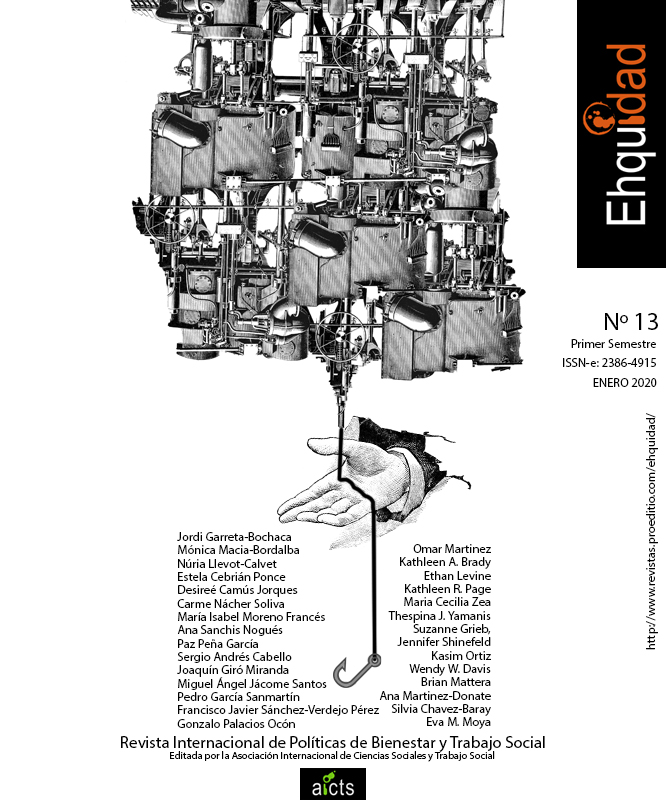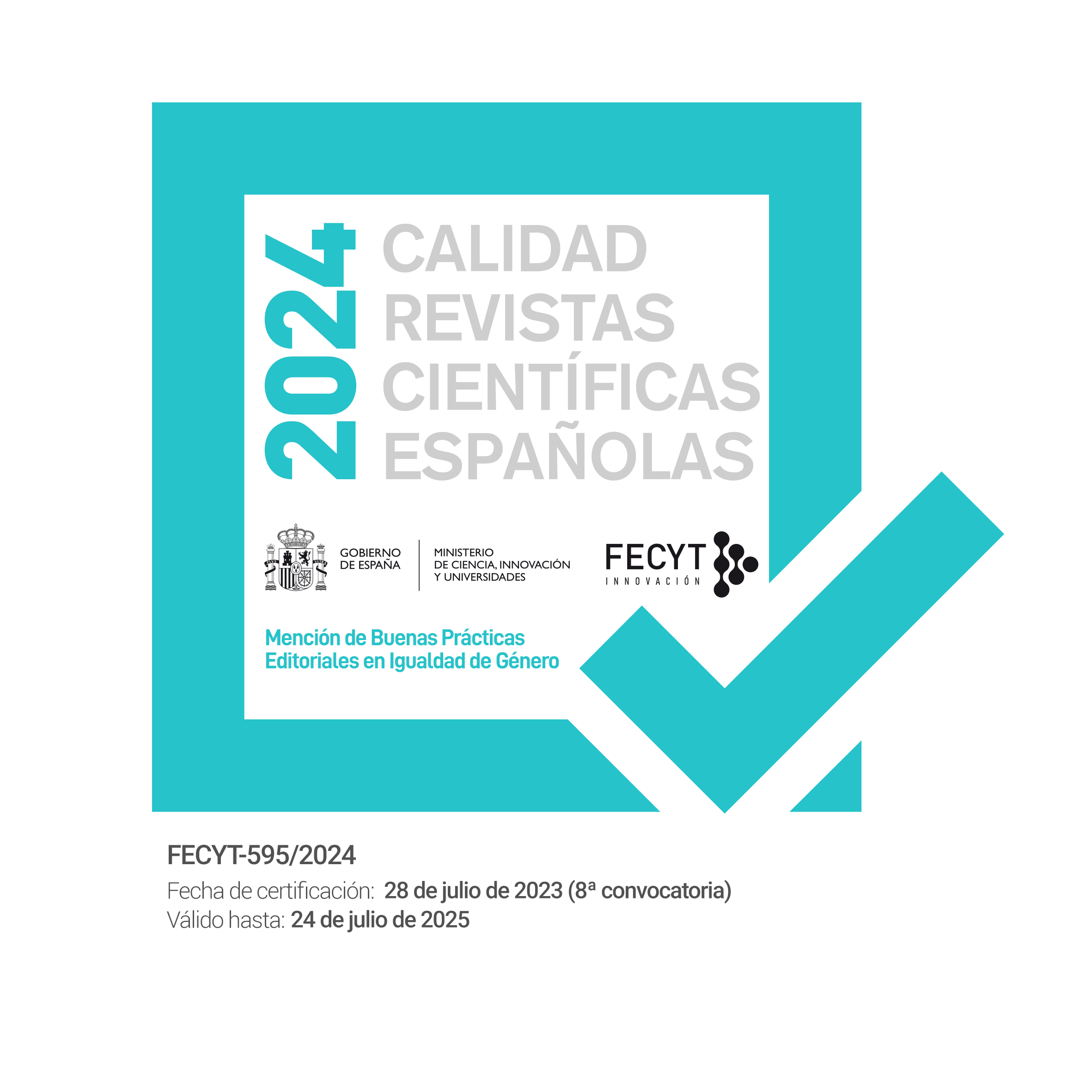Uso de la Teoría Sindémica para examinar el riesgo sexual del VIH entre hombres latinos que tienen sexo con hombres en Filadelfia, Pensilvania: Hallazgos de la Vigilancia Nacional de la Conducta del VIH
DOI:
https://doi.org/10.15257/ehquidad.2020.0009Resumen
Los hombres latinos que tienen sexo con hombres (HSH) continúan siendo desproporcionadamente afectados por el VIH / SIDA. Identificar el papel de múltiples factores sindémicos asociados con las conductas de riesgo sexual es imprescindible para desarrollar estrategias efectivas de prevención y tratamiento. Los datos transversales para este estudio se derivaron de tres ciclos de la parte de Filadelfia del Sistema Nacional de Vigilancia del Comportamiento del VIH. Este estudio exploró el impacto de los factores sindémicos (consumo excesivo de alcohol, sexo de intercambio y discriminación homofóbica) en los comportamientos sexuales de riesgo de VIH, operacionalizados como el número de parejas masculinas y las relaciones anales sin condón (IAC) con parejas principales y casuales entre los HSH latinos (n = 464). Los análisis tomaron dos formas: un enfoque sindémico, usando el número acumulado de condiciones como una variable independiente; y un enfoque no sindémico, que incorpora cada condición como un factor único. En análisis sinádicos multivariables, los participantes con dos o más factores informaron más parejas masculinas y más parejas masculinas casuales CAI que aquellos sin ninguno. En los modelos no sindémicos, la discriminación homofóbica y el intercambio sexual se asociaron significativamente positivamente con el número total de parejas masculinas, mientras que el consumo excesivo de alcohol se asoció con parejas CAI más casuales. Los resultados cuantitativos indican que los enfoques sindémicos y no sindémicos varían en su capacidad relativa para dar cuenta del riesgo sexual entre los HSH latinos.
Descargas
Citas
Ayala, G., Bingham, T., Kim, J., Wheeler, D. P. & Millett, G. A. (2012). Modeling the Impact of Social Discrimination and Financial Hardship on the Sexual Risk of HIV Among Latino and Black Men Who Have Sex With Men. American Journal of Public Health, 102(S2), S242-S249.
Beymer, M. R., Weiss, R. E., Kalkitis, P. N., Kapadia, F., Ompad, D. C., Bourque, L., & Bolan, R. K. (2016). Disparities Within the Disparity--Determining HIV Risk Factors Among Latino Gay and Bisexual Men Attending a Community-Based Clinic in Los Angeles, CA. Journal of Acquired Immune Deficiency Syndromes, 73(2), 237-244.
Bianchi, F. T., Reisen, C. A., Zea, M. C., Poppen, P. J., & Shedlin, M. G. (2007). The sexual experiences of Latino men who have sex with men who migrated to a gay epicentre in the USA. Culture, Health & Sexuality, 9(5), 505-518. Retrieved from http://search.ebscohost.com/login.aspx?direct=
true&db=ant&AN=XRAI2000s72335&site=ehostlive&scope=site&authtype=uid&user=ebony&password=lewis
Carrillo, H. (2004). Sexual Migration, Cross-Cultural Sexual Encounters, and Sexual Health. Sexuality Research & Social Policy: A Journal of the NSRC, 1(3), 58-70. doi:10.1525/srsp.2004.1.3.58
Centers for Disease Control and Prevention. (2010). Prevalence and awareness of HIV infection among men who have sex with men --- 21 cities, United States, 2008. MMWR. Morbidity and Mortality Weekly Report, 59(37), 1201-1207. Retrieved from http://www.ncbi.nlm.nih.gov/pubmed/
Centers for Disease Control and Prevention. (2015). HIV Among Gay and Bisexual Men. Retrieved from https://www.cdc.gov/hiv/group/msm/index.html
Centers for Disease Control and Prevention. (2016). Sexually Transmitted Disease Surveillance 2015. Retrieved from Atlanta, GA:
Centers for Disease Control and Prevention. (2019). CDC Fact Sheet. HIV among Latinos. . Retrieved from Atlanta, GA: Available at: https://www.cdc.gov/nchhstp/newsroom/docs/factsheets/cdc-hiv-latinos-508.pdf.
Deiss, R. G., Brouwer, K. C., Loza, O., Lozada, R. M., Ramos, R., Cruz, M. A. F., . . . Strathdee, S. A. (2008). High-risk sexual and drug using behaviors among male injection drug users who have sex with men in 2 Mexico-US border cities. Sexually Transmitted Diseases, 35(3), 243-249. Retrieved from http://search.ebscohost.com/login.aspx?direct=true&db=cmedm&AN=18046263&site=ehost-live
Diaz, R. M., & Ayala, G. (1999). Love, passion and rebellion: ideologies of HIV risk among Latino gay men in the USA. Culture, Health & Sexuality, 1(3), 277-293. doi:10.1080/136910599301021
Diaz, R. M., Ayala, G., & Bein, E. (2004). Sexual Risk as an Outcome of Social Oppression: Data From a Probability Sample of Latino Gay Men in Three U.S. Cities. Cultural Diversity & Ethnic Minority Psychology, 10(3), 255-267. doi:10.1037/1099-9809.10.3.255
Fernández, M. I., Bowen, G. S., Varga, L. M., Collazo, J. B., Hernandez, N., Perrino, T., & Rehbein, A. (2005). High Rates of Club Drug Use and Risky Sexual Practices Among Hispanic Men Who Have Sex with Men in Miami, Florida. Substance Use & Misuse, 40(9-10), 1347-1362. doi:10.1081/JA-200066904
Frye, V., Egan, J. E., Tieu, H. V., Cerdá, M., Ompad, D. & Koblin, B. A. (2014). "I didn't think I could get out of the fucking park." Gay men's retrospective accounts of neighborhood space, emerging sexuality and migrations. Social Science & Medicine, 104, 6-14.
German, D., Linton, S., Cassidy-Stewart, H. & Flynn, C. (2014). Using Baltimore HIV Behavioral Surveillance Data for Local HIV Prevention Planning. AIDS Behav, 18 Suppl 3, 359-369. doi:10.1007/s10461-013-0513-1
Halkitis, P., Moeller, R., Siconolfi, D., Storholm, E., Solomon, T., & Bub, K. (2013). Measurement Model Exploring a Syndemic in Emerging Adult Gay and Bisexual Men. AIDS & Behavior, 17(2), 662-673 612p. doi:10.1007/s10461-012-0273-3
Hess, K. L., Chavez, P. R., Kanny, D., DiNenno, E., Lansky, A. & Paz-Bailey, G. (2015). Binge drinking and risky sexual behavior among HIV-negative and unknown HIV status men who have sex with men, 20 US cities. Drug and Alcohol Dependence, 147, 46-52.
Hoebbel, C., & Fals-Stewart, W. (2003). The effect of behavioral couples therapy on the degree of indirect risk exposure to HIV among wives of substance-abusing men. Paper presented at the 65th Annual Scientific Meeting of the College on Problems of Drug Dependence, Bal Harbour, FL.
Javanbakht, M., Murphy, R., Harawa, N. T., Smith, L. V., Hayes, M., Chien, M.,& Kerndt, P. R. (2009). Sexually Transmitted Infections and HIV Prevalence among Incarcerated Men Who Have Sex With Men, 2000–2005. Sexually Transmitted Diseases, 36(S2), S17-S21.
Kuhns, L. M., Kwon, S., Ryan, D. T., Garofalo, R., Phillips, G., 2nd, & Mustanski, B. S. (2015). Evaluation of respondent-driven sampling in a study of urban young men who have sex with men. J Urban Health, 92(1), 151-167. doi:10.1007/s11524-014-9897-0
MacKellar, D. A., Gallagher, K. M., Finlayson, T., Sanchez, T., Lansky, A. & Sullivan, P. S. (2007). Surveillance of HIV risk and prevention behaviors of men who have sex with men--a national application of venue-based, time-space sampling. Public Health Rep, 122 Suppl 1, 39-47. Retrieved from http://www.ncbi.nlm.nih.gov/entrez/query.fcgi?cmd=Retrieve&db=PubMed&dopt=Citation&list_uids=17354526
Martinez, O., Arreola, S., Wu, E., Muñoz-Laboy, M., Levine, E. C., Rutledge, S. E., . . . Sandfort, T. (2016). Syndemic Factors Associated with Adult Sexual HIV Risk Behaviors in a Sample of Latino Men Who Have Sex With Men. Drug and Alcohol Dependence. doi:10.1016/j.drugalcdep.2016.06.033
Martinez, O., Isabel Fernandez, M., Wu, E., Carballo-Diéguez, A., Prado, G., Davey, A., . . . Carballo-Diéguez, A. (2018). A couple-based HIV prevention intervention for Latino men who have sex with men: study protocol for a randomized controlled trial. Trials, 19(1), 1-1. doi:10.1186/s13063-018-2582-y
Martinez, O. o. m. t. e., Lopez, N. o. m. t. e., Woodard, T. o. m. t. e., Rodriguez-Madera, S. o. m. t. e., & Icard, L. o. m. t. e. (2019). Transhealth Information Project: A Peer-Led HIV Prevention Intervention to Promote HIV Protection for Individuals of Transgender Experience. Health & Social Work, 44(2), 104-112. doi:10.1093/hsw/hlz008
Mimiaga, M. J., Biello, K. B., Robertson, A. M., Oldenburg, C. E., Rosenberger, J. G., O’Cleirigh, C., . . . Safren, S. A. (2015). High prevalence of multiple syndemic conditions associated with sexual risk behavior and hiv infection among a large sample of spanish- and portuguese-speaking men who have sex with men in latin america. Archives of Sexual Behavior. doi:10.1007/s10508-015-0488-2
Mizuno, Y., Borkowf, C., Millett, G., Bingham, T., Ayala, G. & Stueve, A. (2012). Homophobia and Racism Experienced by Latino Men Who Have Sex with Men in the United States: Correlates of Exposure and Associations with HIV Risk Behaviors. AIDS & Behavior, 16(3), 724-735 712p. doi:10.1007/s10461-011-9967-1
Murphy, R. D., Gorbach, P. M., Weiss, R. E., Hucks-Ortiz, C. & Shoptaw, S. J. (2013). Seroadaptation in a Sample of Very Poor Los Angeles Area Men Who Have Sex with Men. AIDS & Behavior, 17, 1862-1872. doi:10.1007/s10461-012-0213-2
Mustanski, B., II, G. P., Ryan, D. T., Swann, G., Kuhns, L. & Garofalo, R. (2016). Prospective Effects of a Syndemic on HIV and STI Incidence and Risk Behaviors in a Cohort of Young Men Who Have Sex with Men. AIDS And Behavior, 1-13. doi:10.1007/s10461-016-1607-3
Nakamura, N., & Zea, M. C. (2010). Experiences of homonegativity and sexual risk behaviour in a sample of Latino gay and bisexual men. Culture, Health & Sexuality, 12(1), 73-85. doi:10.1080/13691050903089961
O'Leary, A., Jemmott, J. B., 3rd, Stevens, R., Rutledge, S. E. & Icard, L. D. (2014). Optimism and education buffer the effects of syndemic conditions on HIV status among African American men who have sex with men. AIDS And Behavior, 18(11), 2080-2088. doi:10.1007/s10461-014-0708-0
Philadelphia Department of Public Health. (2019). 2018 HIV Surveillance Report. Retrieved fromhttps://www.phila.gov/media/20191101092716/
HIV_10_30_2019_FINAL_web.pdf
Ramirez-Valles, J., Kuhns, L. M., & Manjarrez, D. (2014). Tal Como Somos/just as we are: an educational film to reduce stigma toward gay and bisexual men, transgender individuals, and persons living with HIV/AIDS. Journal Of Health Communication, 19(4), 478-492. doi:10.1080/10810730.2013.821555
Rhodes, S. D., Alonzo, J., Mann, L., Song, E. Y., Tanner, A. E., Arellano, J. E., . . . Painter, T. M. (2017). Small-Group Randomized Controlled Trial to Increase Condom Use and HIV Testing Among Hispanic/Latino Gay, Bisexual, and Other Men Who Have Sex With Men. American Journal of Public Health, 107(6), 969. doi:10.2105/AJPH.2017.303814
Rhodes, S. D., Yee, L. J. & Hergenrather, K. C. (2006). A community-based rapid assessment of HIV behavioural risk disparities within a large sample of gay men in southeastern USA: a comparison of African American, Latino and white men. AIDS Care, 18(8), 1018-1024.
Rietmeijer, C. A., Wolitski, R. J., Fishbein, M., Corby, N. H. & Cohn, D. L. (1998). Sex Hustling, Injection Drug Use, and Non-Gay Identification by Men Who Have Sex With Men: Associations With High-Risk Sexual Behaviors and Condom Use. Sexually Transmitted Diseases, 25(7), 353-360.
Sandfort, T. G., Melendez, R. M. & Diaz, R. M. (2007). Gender nonconformity, homophobia, and mental distress in latino gay and bisexual men. J Sex Res, 44(2), 181-189.
Santos, G.-M., Tri, D., Beck, J., Makofane, K., Arreola, S., Pyun, T., . . . Ayala, G. (2014). Syndemic conditions associated with increased HIV risk in a global sample of men who have sex with men. Sexually Transmitted Infections, 90(3), 250-253. doi:10.1136/sextrans-2013-051318
Shedlin, M. G., Decena, C. U., & Oliver-Velez, D. (2005). Initial acculturation and HIV risk among new Hispanic immigrants. Journal Of The National Medical Association, 97(7 Suppl), 32S-37S. Retrieved from http://libproxy.temple.edu/login?url=http://search.ebscohost.com/login.aspx?direct=true&db=cmedm&AN=16080455&site=ehost-live&scope=site
Singer, M., & Clair, S. (2003). Syndemics and public health: reconceptualizing disease in bio-social context. Medical Anthropology Quarterly, 17(4), 423-441. Retrieved from http://libproxy.temple.edu/login?url=http://search.eb
scohost.com/login.aspx?direct=true&db=cmedm&AN=14716917&site=ehost-live&scope=site
Stappenbeck, C. A., Hoebbel, C. & Fals-Stewart, W. (2004). Women’s indirect risks for HIV exposure: The effects of behavioral couples therapy on wives of drug-abusing men. Paper presented at the 2nd World Congress on Women’s Mental Health, Washington, DC.
Waltz, T. J., Powell, B. J., Fernández, M. E., Abadie, B. & Damschroder, L. J. (2019). Choosing implementation strategies to address contextual barriers: diversity in recommendations and future directions. Implementation Science: IS, 14(1), 42-42. doi:10.1186/s13012-019-0892-4
Wilson, P. A., Nanin, J., Amesty, S., Wallace, S., Cherenack, E. M. & Fullilove, R. (2014). Using syndemic theory to understand vulnerability to HIV infection among Black and Latino men in New York City. Journal Of Urban Health: Bulletin Of The New York Academy Of Medicine, 91(5), 983-998. doi:10.1007/s11524-014-9895-2













